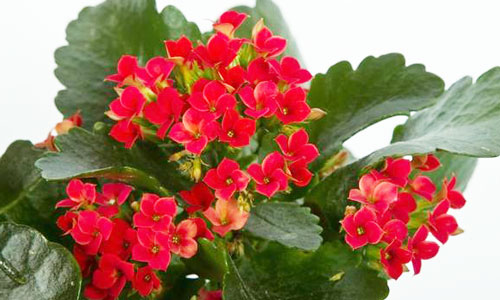Taking an environmentally sensitive approach to pest management
Kalanchoe: The Versatile Houseplant
Published: January 5, 2017

Most houseplants are grown for their attractive foliage. In contrast, there are other potted plants that are prized for their flowers which, unfortunately, are relatively short-lived. Very few plants can boast of colorful, long-lasting flowers and attractive foliage the remainder of the year. Kalanchoe delivers both, making it a very versatile houseplant.
If you received a kalanchoe for Christmas this past holiday season, you have a plant that should provide you with many years of pleasure. Kalanchoe’s small, bright flowers with four petals come in colors of yellow, orange, red, pink and magenta. They are borne in profusion and continue to provide color for several months during the winter. Additionally, their fleshy, succulent leaves with scalloped margins make them an attractive houseplant, even when not in bloom. The fact they can easily be re-bloomed make them even more attractive as a gift plant that “keeps on giving”.
The most widely-grown kalanchoe as a houseplant is Kalanchoe blossfeldiana, or Florist Kalanchoe. It represents an example of a plant whose genus classification also is its common name. Pronunciation of the latter varies. However, most authorities suggest kalanchoe should be pronounced with four syllables, with an accent being placed on the third syllable whose “ch” is pronounced like a “k” (i.e., kal-un-KOH-ee).
Most kalanchoes are native to Madagascar and tropical Africa. One species (Kalanchoe pinnata) often is grown because of its unique method of propagation. When a leaf is cut from the plant, it is able to produce new, young plantlets along its edge. Thus, it is commonly called “air plant”. Another species (Kalanchoe daigremontiana) reproduces viviparously. It bears copious numbers of plantlets along the edges of its leaves while they still are attached to the main plant. These plantlets drop off and readily root around the base of the main plant, giving rise to its common name of “mother-of-thousands”.
The cultural requirements of most kalanchoes are nearly the same. They enjoy bright light and a well-drained growing medium. Plants tend to get “spindly” under low-light conditions and must not be over-watered. Like most succulents, kalanchoes are better “equipped” to handle dry conditions, opposed to wet conditions. Therefore, allow the growing medium to dry slightly before watering. Fertilize with a houseplant fertilizer according to label directions when the plant is making active growth.
Florists Kalanchoe should be provided with a night temperature of about 60 degrees F to grow and flower best. Day temperatures should be maintained about 10 degrees higher than those at night. Temperatures over 75 degrees F tend to delay or reduce flowering.
Like poinsettia, kalanchoe requires short days (long nights) for flowers to develop. For Christmas blooming, short-day treatment should be started around the middle of September. The greatest number of blooms will be produced when kalanchoe is given a dark period of 14 hours. No light should be permitted at any time during the dark period. Of course, following the daily dark period, exposure to light for the remaining ten hours in the day is required if the plant is to bloom.
Kalanchoes destined to be re-bloomed should be kept growing vigorously from the time they stop blooming in the winter until they are exposed to short-days the following September. Therefore, in spring, after the danger of frost has past, the plants can be moved outdoors and placed in light shade or indirect sun. Plants that have grown to be tall and leggy should be cut back to about half of their height. Fertilize during the summer every two to three weeks with a houseplant fertilizer according to label directions.
Bring plants back indoors around Labor Day and begin the short-day treatment described above around mid-September. Feed and water sparingly during flower induction. Plants should bloom in about six weeks.
Kalanchoes, have few insect or disease problems. Over-watering most often results in crown rot which leads to the sudden collapse of the plant. Powdery mildew can be a problem when kalanchoes are grown in a greenhouse, although the relative humidity of the average home is too low for the disease to be a problem.
Propagation of kalanchoes is relatively easy using stem-tip cuttings two to three inches in length whose flowers have been removed. Stick cuttings in a porous germination medium such as a mixture of peat and vermiculite. Maintain a high relative humidity around the cuttings. Rooting should occur within two to three weeks.
Note: Most species of Kalanchoe (including K. blossfeldiana) contain cardiac glycosides which are toxic to many animals, including dogs and cats. Flowers contain more glycosides than other parts of the plant. Because of the hazard kalanchoes pose, the U.S. Food and Drug Administration recommends they should be kept at a safe distance from household pets.
Subscribe to receive similar articles sent directly to your inbox!
- Kalanchoe: The Versatile Houseplant (01/05/17)
REVISED: January 5, 2017